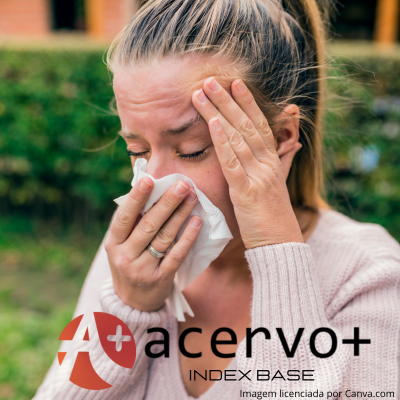Ensaio Metabonômico baseado em Ressonância Magnética Nuclear (RMN) para avaliar o tratamento da rinite alérgica em crianças e adolescentes
##plugins.themes.bootstrap3.article.main##
Resumo
Objetivo: Identificar perfis metabólicos potencialmente associados à adesão ao tratamento e à gravidade da rinite alérgica em crianças e adolescentes. Métodos: Trata-se de um estudo prospectivo desenvolvido em um hospital universitário no Brasil, envolvendo 25 voluntários. Os espectros de RMN ¹H do soro dos voluntários foram obtidos e processados utilizando estatística multivariada. Inicialmente, foi empregada a Análise de Agrupamentos Hierárquicos (HCA) resultando em dois grupos, contendo onze e quatorze amostras cada. Utilizou-se a Análise Discriminante Ortogonal por Mínimos Quadrados (OPLS-DA) para identificar as variáveis responsáveis pela discriminação. Resultados: O autorrelato de adesão dos pacientes ao tratamento mostrou-se falho quando confrontados com os resultados da HCA. A principal diferença entre os grupos foi a resposta ao tratamento. No grupo II , 81,8% dos voluntários não responderam ao tratamento, enquanto no grupo I, esse número foi igual a 42,8%. Alanina, serina, arginina, colina, N-acetil D-glicosamina, glutamato, lactato, glicose, VLDL/LDL foram os metabólitos identificados. Observou-se que o perfil metabólico dos voluntários do Grupo II pode indicar uma condição clínica mais grave em comparação aos do Grupo I. Conclusão: A RMN demonstrou capacidade de identificar a resposta ao tratamento da rinite alérgica, diferenciando pacientes com formas mais graves e crônicas da doença.
##plugins.themes.bootstrap3.article.details##
Copyright © | Todos os direitos reservados.
A revista detém os direitos autorais exclusivos de publicação deste artigo nos termos da lei 9610/98.
Reprodução parcial
É livre o uso de partes do texto, figuras e questionário do artigo, sendo obrigatória a citação dos autores e revista.
Reprodução total
É expressamente proibida, devendo ser autorizada pela revista.
Referências
2. BOUSQUET J, et al. Allergic Rhinitis and its Impact on Asthma (ARIA) 2008 update (in collaboration with the World Health Organization, GA (2) LEN and AllerGen). Allergy, 2008; 63(Suppl 86): 8-160.
3. COMHAIR SAA, et al. Metabolomic Endotype of Asthma. Journal of Immunology, 2015; 195(2): 643-650.
4. CZECH EJ, et al. Allergic Rhinitis. Primary Care, 2023; 50(2): 159-178.
5. EMBADE N, et al. Metabolic Characterization of Advanced Liver Fibrosis in HCV Patients as Studied by Serum 1H-NMR Spectroscopy. PLoS One, 2016; 11(5): e0155094.
6. GAO H, et al. The metabonomic study of Shaoyao-Gancao decoction in a rat model of acute bronchial asthma by 1 H NMR. Analytical Methods, 2016; 8(3): 570-581.
7. HOLMES J, HEANEY LG. Measuring adherence to therapy in airways disease. Breathe, 2021; 17(2): 210037.
8. HUANG K, et al. Systematic Review of NMR-Based Metabolomics Practices in Human Disease Research. Metabolites, 2022; 12(10):.2-15.
9. HUGTENBURG JG, et al. Definitions, variants, and causes of nonadherence with medication: a challenge for tailored interventions. Patient Preference and Adherence, 2013; 7: 675-682.
10. KELLY RS, et al. Asthma Metabolomics and the Potential for Integrative Omics in Research and the Clinic. Chest, 2017; 151(2): 262–277.
11. LIU YL, et al. Allergen detection and logistic multifactor analysis of allergic rhinitis. European Review for Medical and Pharmacological Sciences, 2023; 27(7): 2751-2758.
12. MA GC, et al. Serum metabolomics study of patients with allergic rhinitis. Biomedical Chromatography, 2020; 34(3): e4739.
13. NETO FTL, et al. 1H NMR-based metabonomics for infertility diagnosis in men with varicocele. Journal of Assisted Reproduction and Genetics, 2020; 37(9): 2233-2247.
14. NICHOLSON JK, et al. “Metabonomics”: understanding the metabolic responses of living systems to pathophysiological stimuli via multivariate statistical analysis of biological NMR spectroscopic data. Xenobiotica, 1999; 29(11): 1181–1189.
15. NIETO A, et al. Pediatric allergy and immunology in Spain. Pediatric Allergy and Immunology, 2011; 22(7): 742-750.
16. OSTERBERG L, BLASCHKE T. Adherence to medication. New England Journal of Medicine, 2005; 353(5): 487-497.
17. PAPI A, et al. Relationship of Inhaled Corticosteroid Adherence to Asthma Exacerbations in Patients with Moderate-to-Severe Asthma. Journal of Allergy and Clinical Immunology: In Practice, 2018; 6(6): 1989-1998.e3.
18. PASSALI D, et al. The International Study of the Allergic Rhinitis Survey: outcomes from 4 geographical regions. Asia Pacific Allergy, 2018; 8(1): e7.
19. PONTES TA, et al. Osteopenia-osteoporosis discrimination in postmenopausal women by 1H NMR-based metabonomics. PLoS ONE, 2019; 14(5):1–10.
20. ROLIM AEH, et al. Lipidomics in the study of lipid metabolism: Current perspectives in the omic sciences. Gene, 2015; 554(2): 131-139.
21. SAGDIC O, et al. Total phenolic content, antiradical, antioxidant and antimicrobial activities of Rhododendron honeys. Food Chemistry, 2010; 121: 238–243.
22. SCHULER IV CF, MONTEJO JM. Allergic Rhinitis in Children and Adolescents. Immunology and Allergy Clinics of North America, 2021; 41(4): 613-625.
23. SCHULER IV CF; MONTEJO, JM. Allergic Rhinitis in Children and Adolescents. Pediatric Clinics of North America, 2019; 66(5): 981-993.
24. VIGNOLI A, et al. NMR-Based Metabolomics to Evaluate Individual Response to Treatments. Handbook of Experimental Pharmacology, 2023; 277: 209-245.
25. VILLASEÑOR A, et al. Allergic asthma: an overview of metabolomic strategies leading to the identification of biomarkers in the field. Clinical & Experimental Allergy, 2017; 47(4): 442-456.
26. WANG Y, et al. Characterization of dysbiosis of the conjunctival microbiome and nasal microbiome associated with allergic rhinoconjunctivitis and allergic rhinitis. Frontiers in Immunology, 2023; 14: 1079154.
27. WORLD HEALTH ORGANIZATION. (2003). Adherence to long-term therapies: evidence for action. World Health Organization. Available in: https://iris.who.int/handle/10665/42682. Accessed on: January 12, 2023.
28. XIE S, et al. Prediction of Sublingual Immunotherapy Efficacy in Allergic Rhinitis by Serum Metabolomics Analysis. International Immunopharmacology, 2021; 90: 107211.
29. ZHANG W, et al. Effects of physical therapy on lung function in children with asthma: a systematic review and meta-analysis. Pediatric Research, 2021; 89(6): 1343-1351.
30. ZHOU Y, et al. 1H NMR-based metabolomic study of metabolic profiling for pollinosis. The World Allergy Organization Journal, 2019; 12(1): 100005.

